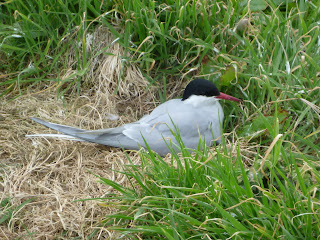As a birdwatcher, there are certain events that I look forward to every year, such as the first returning summer migrants or winter thrushes. Another event that I always enjoy is this early summer evening visit to
Clumber Park, in Nottinghamshire, to look for the
Nightjars and
Woodcock.
Clumber lake with Greylag Geese
Tonight's visit, run as part of the
Chesterfield RSPB's programme of events, began at 7pm in the chapel car park where the first birds, a beautiful pair of
Stock Doves were seen in one of the nearby trees. Walking down to the lake we soon spotted
Swift (dozens feeding low over the water),
Swallow,
House and
Sand Martin. Waterbirds were present on the lake itself and included
Gadwall,
Coot, Mute Swan,
Mallard,
Canada and
Greylag Goose, all with young in tow.
Coot's nest and young
Other waterbirds seen, but which didn't have young were
Moorhen, Tufted Duck and a pair of
Shoveler, the male of which was going into
eclipse plumage.
The walk continued down the side of the water where we managed to locate a few more summer migrants with
Chiffchaff,
Willow Warbler and a
Blackcap/Garden Warbler all singing. An
Oystercatcher found feeding on the grass, was an unusual sight and was my first at this site. The highlight, however, of this part of the walk was a pair of
Spotted Flycatcher that we managed to find and watch "flycatching" on the far side of the lake.
At about 9.15pm we headed back to the car park and drove to another area of the park where we had seen both
Nightjar and
Woodcock in previous years. We got in position next to an area of cleared plantation and waited for the light to fade.
Nightjar habitat in Clumber Park
Whilst waiting for the first
Nightjars, we heard a distinctive call and saw a couple of Woodcock
"roding" overhead. A
Cuckoo was also calling, but wasn't seen. After about half an hour (about 9.40pm before the I think!)
we heard the first "churring" and its wasn't long before
Nightjars appeared flying low overhead. At one point we had 2 birds singing at the same time and saw at least 3 birds, including a female that flew up from the floor, presumably from a hidden nest. If you've never herard a
Nightjar "churring", follow
this link, it's an amazing sound!!
The evening ended at about 10.30pm and we all left the area leaving the birds churring away. Many thanks to all that attended.



































